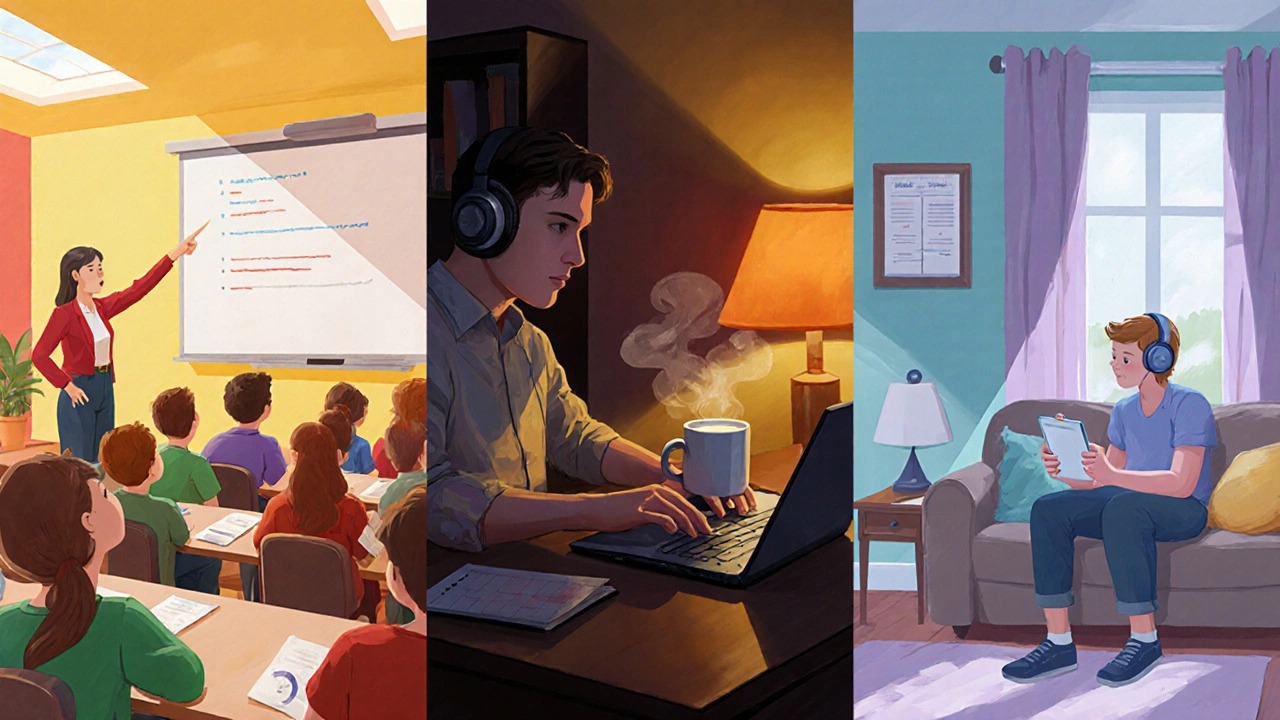Basic Computer Course Duration Estimator
How Long Will Your Course Take?
Select your weekly commitment and preferred learning style to estimate your course duration.
Trying to figure out how many months a basic computer course is a beginner‑level training program that teaches essential computer skills such as operating systems, office applications, internet safety, and basic troubleshooting lasts can feel like a guessing game. The answer isn’t a one‑size‑fits‑all number because several factors shape the timeline. In this guide we break down the typical length, the variables that stretch or shrink it, and how to plan your own schedule so you know exactly when you’ll be ready for the certification.
Key Takeaways
- Most full‑time basic computer courses finish in 2-3 months.
- Part‑time and self‑paced options can extend the timeline to 4-6 months.
- Curriculum depth, delivery mode, and your prior experience are the biggest duration drivers.
- Upon completion you usually earn a Certificate of Completion or an entry‑level IT certification.
- Mapping the course to a personal calendar helps you stay on track and avoid common pitfalls.
Typical Length of a Basic Computer Course
When you enroll in a structured program, most training providers design the curriculum to fit within a 60‑ to 90‑hour total contact time. If the class meets every weekday for three hours, you’re looking at roughly eight to twelve weeks - that’s about two to three months. This is the standard for full‑time delivery where learners attend classes Monday through Friday and receive daily hands‑on practice.
For learners who can only study evenings or weekends, the same 60‑ to 90‑hour curriculum stretches to 12‑16 weeks, translating to three to four months. Self‑paced online platforms let you spread the material over six months or even a full year, but most diligent students finish within four to six months.
What Influences the Duration?
Several elements can either trim or lengthen the time you spend in the program:
- Curriculum scope - A narrow curriculum focused on core skills like using Windows, Microsoft Office, and basic internet navigation wraps up faster than a broader one that adds introductory coding or graphic design.
- Delivery format - online learning allows flexible pacing, while in‑person classes enforce a stricter schedule.
- Instructor expertise - Experienced instructors who can explain concepts quickly and answer questions on the spot often reduce the time needed for students to grasp fundamentals.
- Learning platform features - Platforms that include built‑in quizzes, video tutorials, and hands‑on labs virtual environments where students practice tasks without a physical computer keep momentum high.
- Assessment frequency - Regular assessments short quizzes and practical tests help identify gaps early, preventing costly re‑learning later.
- Skill level coming in - If you already know how to type or navigate the web, you’ll breeze through the basics. Absolute beginners may need extra practice sessions.

Full‑Time vs Part‑Time vs Self‑Paced: A Quick Comparison
| Option | Weekly Hours | Total Weeks | Typical Calendar Length | Best For |
|---|---|---|---|---|
| Full‑Time | 15‑20 | 8‑12 | 2‑3 months | Students who can attend daily and want a fast track |
| Part‑Time | 6‑10 | 12‑16 | 3‑4 months | Working adults or parents juggling other duties |
| Self‑Paced | Varies | 24‑30 | 4‑6 months (or longer if you choose) | Anyone needing maximum flexibility |
What Certification Do You Earn?
Most providers award a certificate of completion that confirms you’ve mastered the course objectives and can perform basic computer tasks in a professional setting. Some also partner with recognized bodies like the Computing Technology Industry Association (CompTIA) to give you an entry‑level IT certification such as ITF+ (IT Fundamentals). These credentials add a tangible boost to a résumé and are often enough to qualify for junior admin or help‑desk roles.
How to Map the Course to Your Schedule
Start by answering three quick questions:
- How many hours per week can you realistically dedicate?
- Do you prefer a fixed class time or the freedom to study whenever?
- What milestone do you need (e.g., certification for a new job) and by when?
Plug those answers into the comparison table above. If you can commit 12 hours weekly, the part‑time path will land you a certificate in about three months. If your schedule is erratic, aim for the self‑paced route but set personal check‑points every two weeks to stay on track.
Use a simple spreadsheet: list each module, estimate the hours, and mark the start and finish dates. Treat the spreadsheet like a project plan - move forward only when the previous module’s assessment has been passed. This prevents you from stacking unfinished lessons and keeps motivation high.

Common Pitfalls & How to Avoid Them
- Over‑loading yourself. Trying to cram 20 hours a week when you only have 10 leads to burnout. Stick to realistic weekly targets.
- Skipping hands‑on practice. Theory without hands‑on labs means you won’t build muscle memory for tasks like file management or email etiquette. Schedule lab time right after each lecture.
- Neglecting assessments. Treat quizzes as mandatory checkpoints. They highlight gaps before they become bigger problems.
- Choosing the wrong delivery mode. If you learn best in a classroom, an online‑only program may slow you down. Many providers offer a hybrid blend - consider that if you’re unsure.
Next Steps
Ready to lock in your timeline? Here’s a quick action plan:
- Research local colleges, community centers, or reputable online platforms that list a basic computer course with clear duration details.
- Compare the three options in the table above against your weekly availability.
- Contact the instructor or admissions office to confirm start dates and any prerequisite knowledge.
- Set up a study calendar and mark the first assessment date.
- Begin the first module and track progress weekly - adjust your plan if needed.
By following these steps you’ll know exactly how many months your basic computer course will take and you’ll avoid the surprise extensions that frustrate many learners.
Frequently Asked Questions
What is the shortest possible time to finish a basic computer course?
If you enroll in an intensive full‑time program that meets five days a week for three hours each day, you can complete the 60‑ to 90‑hour curriculum in about eight weeks, so roughly two months.
Can I get a recognized certification after the course?
Most basic computer courses award a Certificate of Completion. Some providers also offer entry‑level IT certifications like CompTIA ITF+, which are industry‑recognized and can be listed on a résumé.
Is online learning slower than classroom learning?
Online courses give you flexibility, but speed depends on how many hours you allocate each week. If you commit the same weekly hours as a classroom, the total calendar time is usually similar.
Do I need any prior knowledge before starting?
No formal background is required. The course assumes zero experience and builds skills from the ground up, though basic familiarity with turning on a computer can help you keep pace.
How many hours of practice are recommended each week?
Aim for at least 6‑8 hours of hands‑on practice in addition to lecture time. Consistent practice reinforces concepts and reduces the need for extra tutoring.





Write a comment